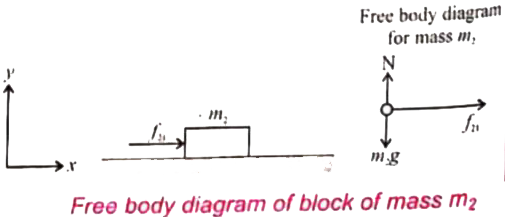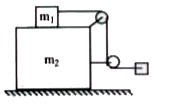Two blocks of masses m1 and m2(m1>m2) in contact with each other on frictionless, horizontal surface. If a horizontal force F is given onm1 set into motion with acceleration a, then reaction force on mass m1 by m2 isSolution in Tamil
Let us consider two blocks of masses m1 and m2(m1>m2) . Kept in contact with each other on a smooth horizontal frictional surface as shown in the figure

By the application of a horizontal force F both the blocks are set into motion with acceleration a simultaneously in the direction of the force F .
To find the acceleration →a Newton's second law has to be applied to the system mass m=m1+m2
If we select the motion of the two masses along the positive x direction Fˆj=maˆi
The acceleration of the system is given by
∴,a=Fm1+m2
The force exerted by teh block m1 on m2 due to its motion is called force of contact (fn) According to Newton's third law the block m2 will exert an equivalent opposite reaction
Figure shows the free body diagram of block m1

Fˆi−f12ˆi=m1aˆi
By comparing the components of the above equation we get
F−f12=m1a
f12=F−m1a
Substituting the value of acceleration from equation (1) in (2) we get
f12=f−m1Fm1+m2
F12=Fm2m1+m2
Equation (3) shows that the magnitude of contact force depends on mass m2 which provides the reaction force . Note that this force is acting along the negative x direction m1 is given by f12=−Fm2m1+m2
For m2 there is only one force force acting on it the x direction and it is denoted by f21 . this force is exerted by mass m1 .the free body diagram for mass m2 is shown in the figure .

Applying Newton' second law for mass m2
f21ˆi=m2ˆi
By comparing the components on both sides of the above equation
f21=m2a
Substituting for acceleration from equation
(1) in equation (4) we get
f21=Fm2m1+m2
In this case the magnitude of the contact force is f21=Fmm1+m2
Topper's Solved these Questions
- LAW OF MOTION BOOK - PREMIERS PUBLISHERSCHAPTER - LAW OF MOTION EXERCISE - OTHER IMPORTANT QUESTIONS & ANSWERS (V Conceptual Question )
16 Videos
- LAW OF MOTION BOOK - PREMIERS PUBLISHERSCHAPTER - LAW OF MOTION EXERCISE - OTHER IMPORTANT QUESTIONS & ANSWERS (VI Numerical Problems)
62 Videos
- LAW OF MOTION BOOK - PREMIERS PUBLISHERSCHAPTER - LAW OF MOTION EXERCISE - OTHER IMPORTANT QUESTIONS & ANSWERS (III Short Answer Question )
42 Videos
- KINETIC THEORY OF GASESBOOK - PREMIERS PUBLISHERSCHAPTER - KINETIC THEORY OF GASESEXERCISE - OTHER IMPORTANT QUESTIONS & ANSWERS (VI. Conceptual Questions.)
8 Videos
- MOTION OF SYSTEM OF PARTICLES AND BODIESBOOK - PREMIERS PUBLISHERSCHAPTER - MOTION OF SYSTEM OF PARTICLES AND BODIESEXERCISE - OTHER IMPORTANT QUESTIONS & ANSWER (NUMERICAL PROBLEMS)
60 Videos
Similar Questions
Why is it necessary to bend kness while jumping from greater height
View SolutionA scooterist moving with a speed of 36mkmh−1 sees a child standing in the middle of the raod he applies the brakes and brings the scooter to rest in 5s just in time to saved child calculate the average retarding force on the vehicle if mass of the vehicle and drive is 300 kg
View SolutionWhat do you mean by inertia of motion? Give one example
View SolutionWhen an automobile travels for a long distance , the air pressure in the tyres increases slightly . Why ?
View SolutionThe distance between the centres of carbon and oxyen atoms in the carbonmonoxid gas molecule is 1.13Å. Locate the centre of amss of the gas molecule relative to the carbon atom.
View SolutionFind the acceleration of centre of mass of the blocks of masses m1,m2(m1>m2) in Atwood's machine.
View SolutionIf two masses m_1" and "m_2 are experiencing the same force, then the ratio of respective acceleration is
View SolutionTwo particles A1andB2 of masses m1andm2(m1>m2) have the same de Broglie wavelength . Then
View SolutionTwo masses M1 and m2 are experiencing the same force where m1<m2 the ratio of their acceleration a1a2 is
View SolutionThe acceleration of two bodies of mass m1 and m2 in contact on a horizontal surface is
View SolutionTwo blocks of masses m1 and m2(m1>m2) in contact with each other on frictionless, horizontal surface. If a horizontal force F is given onm1 set into motion with acceleration a, then reaction force on mass m1 by m2 is
View SolutionIf two masses m_1 and m_2 (m_1 gt m_2) tied to string moving over a frictionless pulley, then acceleration of masses
View SolutionTwo blocks of masses M_1 and M_2 are placed in contact with each other on a frictionless horizontal surface. If a force F is applied on the block of mass M, what is the contact force between the two blocks?
View SolutionIn the arrangement shown in the figure all surfaces are frictionless, the masses of the block are m1=20kgandm2=30kg. The accelerations of masses m1andm2 will be if F = 180N.

View SolutionTwo bodies of masses m1 and m2 are separated by certain distance. If →F12 is the force on m1 due to m2 and →F21 is the force on m2 due to m1 , then
View SolutionGravitational force between masses m1 and m2 is F. If a third mass m3 is placed near m1 and m2, then the force between m1 and m2 would be
View Solution
